+ データを開く
データを開く
- 基本情報
基本情報
| 登録情報 | データベース: PDB / ID: 1lat | ||||||
|---|---|---|---|---|---|---|---|
| タイトル | GLUCOCORTICOID RECEPTOR MUTANT/DNA COMPLEX | ||||||
 要素 要素 |
| ||||||
 キーワード キーワード | TRANSCRIPTION/DNA / GLUCOCORTICOID RECEPTOR / DNA BINDING REGULATORY PROTEIN / TRANSCRIPTION-DNA COMPLEX | ||||||
| 機能・相同性 |  機能・相同性情報 機能・相同性情報nuclear receptor-mediated corticosteroid signaling pathway / negative regulation of behavioral fear response / HSP90 chaperone cycle for steroid hormone receptors (SHR) in the presence of ligand / muscle atrophy / negative regulation of synaptic plasticity / positive regulation of nuclear receptor-mediated glucocorticoid signaling pathway / nuclear receptor-mediated glucocorticoid signaling pathway / response to inactivity / negative regulation of long-term synaptic depression / regulation of glucocorticoid biosynthetic process ...nuclear receptor-mediated corticosteroid signaling pathway / negative regulation of behavioral fear response / HSP90 chaperone cycle for steroid hormone receptors (SHR) in the presence of ligand / muscle atrophy / negative regulation of synaptic plasticity / positive regulation of nuclear receptor-mediated glucocorticoid signaling pathway / nuclear receptor-mediated glucocorticoid signaling pathway / response to inactivity / negative regulation of long-term synaptic depression / regulation of glucocorticoid biosynthetic process / nuclear glucocorticoid receptor activity / SUMOylation of intracellular receptors / positive regulation of cell growth involved in cardiac muscle cell development / steroid hormone binding / Nuclear Receptor transcription pathway / response to mercury ion / glucocorticoid metabolic process / response to cortisol / neuroinflammatory response / Leydig cell differentiation / mammary gland duct morphogenesis / microglia differentiation / cellular response to magnesium ion / maternal behavior / response to arsenic-containing substance / astrocyte differentiation / negative regulation of vascular permeability / positive regulation of glutamate secretion / adrenal gland development / cellular response to glucocorticoid stimulus / regulation of gluconeogenesis / response to corticosterone / cellular response to steroid hormone stimulus / response to dexamethasone / positive regulation of dendritic spine development / motor behavior / hormone binding / androgen metabolic process / regulation of glucose metabolic process / associative learning / response to electrical stimulus / estrogen response element binding / cellular response to dexamethasone stimulus / nuclear receptor-mediated steroid hormone signaling pathway / cellular response to transforming growth factor beta stimulus / postsynaptic density, intracellular component / core promoter sequence-specific DNA binding / steroid binding / heat shock protein binding / Hsp70 protein binding / transcription initiation-coupled chromatin remodeling / lung development / TBP-class protein binding / positive regulation of cytokine production / response to activity / RNA polymerase II transcription regulatory region sequence-specific DNA binding / synaptic transmission, glutamatergic / promoter-specific chromatin binding / Hsp90 protein binding / female pregnancy / response to insulin / circadian rhythm / response to calcium ion / receptor tyrosine kinase binding / response to wounding / positive regulation of miRNA transcription / DNA-binding transcription repressor activity, RNA polymerase II-specific / spindle / nuclear receptor activity / sequence-specific double-stranded DNA binding / positive regulation of neuron apoptotic process / regulation of cell population proliferation / double-stranded DNA binding / protein-containing complex assembly / DNA-binding transcription activator activity, RNA polymerase II-specific / gene expression / dendritic spine / sequence-specific DNA binding / transcription coactivator activity / nuclear speck / RNA polymerase II cis-regulatory region sequence-specific DNA binding / chromatin remodeling / DNA-binding transcription factor activity / negative regulation of DNA-templated transcription / centrosome / chromatin binding / regulation of DNA-templated transcription / regulation of transcription by RNA polymerase II / protein kinase binding / negative regulation of apoptotic process / chromatin / protein-containing complex binding / glutamatergic synapse / negative regulation of transcription by RNA polymerase II / positive regulation of transcription by RNA polymerase II / protein-containing complex / mitochondrion / DNA binding / zinc ion binding / identical protein binding 類似検索 - 分子機能 | ||||||
| 生物種 |  | ||||||
| 手法 |  X線回折 / X線回折 /  シンクロトロン / 解像度: 1.9 Å シンクロトロン / 解像度: 1.9 Å | ||||||
 データ登録者 データ登録者 | Gewirth, D.T. / Sigler, P.B. | ||||||
 引用 引用 |  ジャーナル: Nat.Struct.Biol. / 年: 1995 ジャーナル: Nat.Struct.Biol. / 年: 1995タイトル: The basis for half-site specificity explored through a non-cognate steroid receptor-DNA complex. 著者: Gewirth, D.T. / Sigler, P.B. | ||||||
| 履歴 |
|
- 構造の表示
構造の表示
| 構造ビューア | 分子:  Molmil Molmil Jmol/JSmol Jmol/JSmol |
|---|
- ダウンロードとリンク
ダウンロードとリンク
- ダウンロード
ダウンロード
| PDBx/mmCIF形式 |  1lat.cif.gz 1lat.cif.gz | 72.5 KB | 表示 |  PDBx/mmCIF形式 PDBx/mmCIF形式 |
|---|---|---|---|---|
| PDB形式 |  pdb1lat.ent.gz pdb1lat.ent.gz | 50.7 KB | 表示 |  PDB形式 PDB形式 |
| PDBx/mmJSON形式 |  1lat.json.gz 1lat.json.gz | ツリー表示 |  PDBx/mmJSON形式 PDBx/mmJSON形式 | |
| その他 |  その他のダウンロード その他のダウンロード |
-検証レポート
| 文書・要旨 |  1lat_validation.pdf.gz 1lat_validation.pdf.gz | 441.4 KB | 表示 |  wwPDB検証レポート wwPDB検証レポート |
|---|---|---|---|---|
| 文書・詳細版 |  1lat_full_validation.pdf.gz 1lat_full_validation.pdf.gz | 452.9 KB | 表示 | |
| XML形式データ |  1lat_validation.xml.gz 1lat_validation.xml.gz | 14.5 KB | 表示 | |
| CIF形式データ |  1lat_validation.cif.gz 1lat_validation.cif.gz | 21.4 KB | 表示 | |
| アーカイブディレクトリ |  https://data.pdbj.org/pub/pdb/validation_reports/la/1lat https://data.pdbj.org/pub/pdb/validation_reports/la/1lat ftp://data.pdbj.org/pub/pdb/validation_reports/la/1lat ftp://data.pdbj.org/pub/pdb/validation_reports/la/1lat | HTTPS FTP |
-関連構造データ
- リンク
リンク
- 集合体
集合体
| 登録構造単位 | 
| ||||||||
|---|---|---|---|---|---|---|---|---|---|
| 1 |
| ||||||||
| 単位格子 |
|
- 要素
要素
| #1: DNA鎖 | 分子量: 5819.784 Da / 分子数: 2 / 由来タイプ: 合成 #2: タンパク質 | 分子量: 9370.214 Da / 分子数: 2 Mutation: G458E, S459G, V462A, A477K, G478Y, R479E, N480G, D481K 由来タイプ: 組換発現 / 由来: (組換発現)   #3: 化合物 | ChemComp-ZN / #4: 水 | ChemComp-HOH / | |
|---|
-実験情報
-実験
| 実験 | 手法:  X線回折 / 使用した結晶の数: 1 X線回折 / 使用した結晶の数: 1 |
|---|
- 試料調製
試料調製
| 結晶 | マシュー密度: 2.84 Å3/Da / 溶媒含有率: 56.72 % | ||||||||||||||||||||||||||||||||||||||||||||||||||||||
|---|---|---|---|---|---|---|---|---|---|---|---|---|---|---|---|---|---|---|---|---|---|---|---|---|---|---|---|---|---|---|---|---|---|---|---|---|---|---|---|---|---|---|---|---|---|---|---|---|---|---|---|---|---|---|---|
| 結晶化 | 温度: 277 K / 手法: 蒸気拡散法, ハンギングドロップ法 / pH: 6 詳細: pH 6.00, VAPOR DIFFUSION, HANGING DROP, temperature 277.00K | ||||||||||||||||||||||||||||||||||||||||||||||||||||||
| 溶液の組成 |
| ||||||||||||||||||||||||||||||||||||||||||||||||||||||
| 結晶化 | *PLUS 温度: 4 ℃ / pH: 6 | ||||||||||||||||||||||||||||||||||||||||||||||||||||||
| 溶液の組成 | *PLUS
|
-データ収集
| 回折 | 平均測定温度: 103 K |
|---|---|
| 放射光源 | 由来:  シンクロトロン / サイト: シンクロトロン / サイト:  CHESS CHESS  / ビームライン: F1 / 波長: 0.908 Å / ビームライン: F1 / 波長: 0.908 Å |
| 検出器 | タイプ: FUJI / 検出器: IMAGE PLATE / 日付: 1993年8月16日 |
| 放射 | プロトコル: SINGLE WAVELENGTH / 単色(M)・ラウエ(L): M / 散乱光タイプ: x-ray |
| 放射波長 | 波長: 0.908 Å / 相対比: 1 |
| 反射 | 解像度: 1.9→6 Å / Num. obs: 26580 / % possible obs: 96.6 % / Observed criterion σ(I): -3 / 冗長度: 4.7 % / Rmerge(I) obs: 0.06 |
| 反射 | *PLUS 最高解像度: 1.9 Å / 最低解像度: 6 Å / % possible obs: 96.6 % / 冗長度: 4.7 % |
- 解析
解析
| ソフトウェア |
| ||||||||||||||||||||||||||||||||||||||||||||||||||||||||||||
|---|---|---|---|---|---|---|---|---|---|---|---|---|---|---|---|---|---|---|---|---|---|---|---|---|---|---|---|---|---|---|---|---|---|---|---|---|---|---|---|---|---|---|---|---|---|---|---|---|---|---|---|---|---|---|---|---|---|---|---|---|---|
| 精密化 | 解像度: 1.9→6 Å / σ(F): 2
| ||||||||||||||||||||||||||||||||||||||||||||||||||||||||||||
| 精密化ステップ | サイクル: LAST / 解像度: 1.9→6 Å
| ||||||||||||||||||||||||||||||||||||||||||||||||||||||||||||
| 拘束条件 |
| ||||||||||||||||||||||||||||||||||||||||||||||||||||||||||||
| ソフトウェア | *PLUS 名称:  X-PLOR / 分類: refinement X-PLOR / 分類: refinement | ||||||||||||||||||||||||||||||||||||||||||||||||||||||||||||
| 精密化 | *PLUS 最高解像度: 1.9 Å / 最低解像度: 6 Å / σ(F): 2 / % reflection Rfree: 10 % / Rfactor obs: 0.195 | ||||||||||||||||||||||||||||||||||||||||||||||||||||||||||||
| 溶媒の処理 | *PLUS | ||||||||||||||||||||||||||||||||||||||||||||||||||||||||||||
| 原子変位パラメータ | *PLUS |
 ムービー
ムービー コントローラー
コントローラー






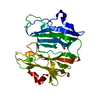
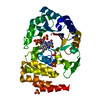
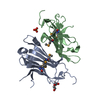

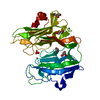
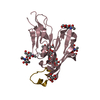
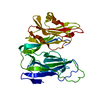
 PDBj
PDBj









































